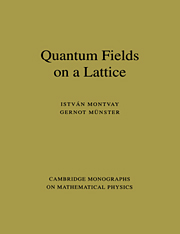6 - Higgs and Yukawa models
Published online by Cambridge University Press: 22 September 2009
Summary
The electroweak interactions in the Standard Model are described by a chiral SU(2)L ⊗ U(1)Y symmetric gauge theory. The chiral symmetry is spontaneously broken by the vacuum expectation value of the scalar Higgs boson field. The consequence of the spontaneous symmetry breaking is that most of the elementary particles (weak vector bosons, quarks and leptons) become massive through their coupling to the Higgs boson field [A3,A4]. The study of non-perturbative spontaneous symmetry breaking is one of the main motivations for the lattice investigations of the Higgs sector in the Standard Model.
Another important aspect is the mathematically rigorous definition of the chiral SU(2)L ⊗ U(1)Y symmetric quantum field theory by means of the continuum limit of a suitably discretized lattice theory. In QCD the coupling is asymptotically free, therefore the continuum limit is defined near the ultraviolet stable Gaussian fixed point at zero coupling (see, for instance, in fig. 5.7). The couplings in the electroweak sector, with the exception of the SU(2)L gauge coupling, are not asymptotically free, therefore the Gaussian fixed point at zero couplings is ultraviolet unstable. This means that the lines of constant physics do not converge to the Gaussian fixed point, as in fig. 5.7. The simplest assumption which makes the definition of a continuum limit possible is that there is another, non-trivial (non-Gaussian) fixed point, somewhere else in the bare parameter space, where the lines of constant physics converge.
- Type
- Chapter
- Information
- Quantum Fields on a Lattice , pp. 318 - 373Publisher: Cambridge University PressPrint publication year: 1994



